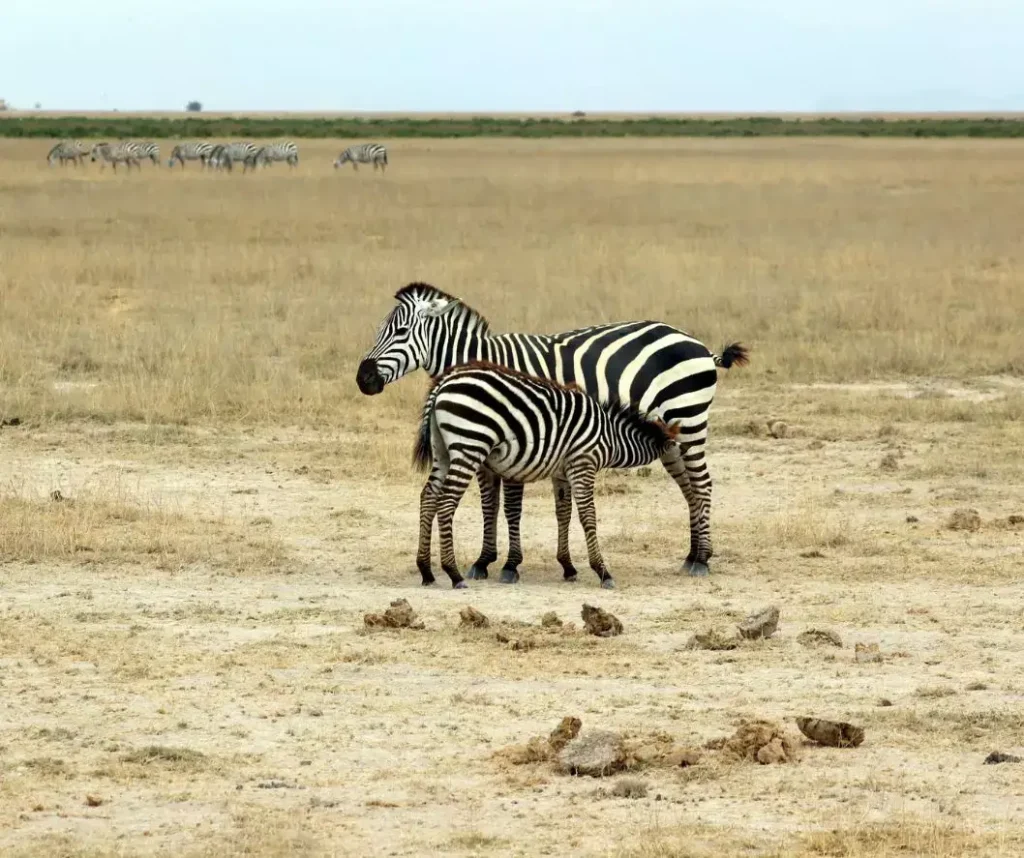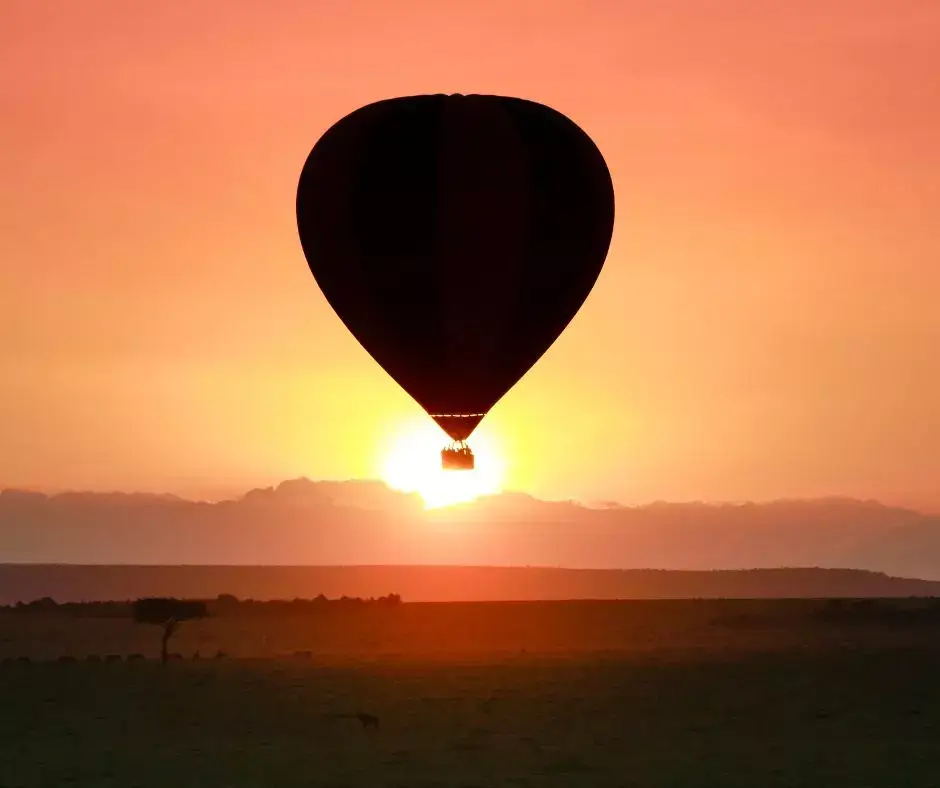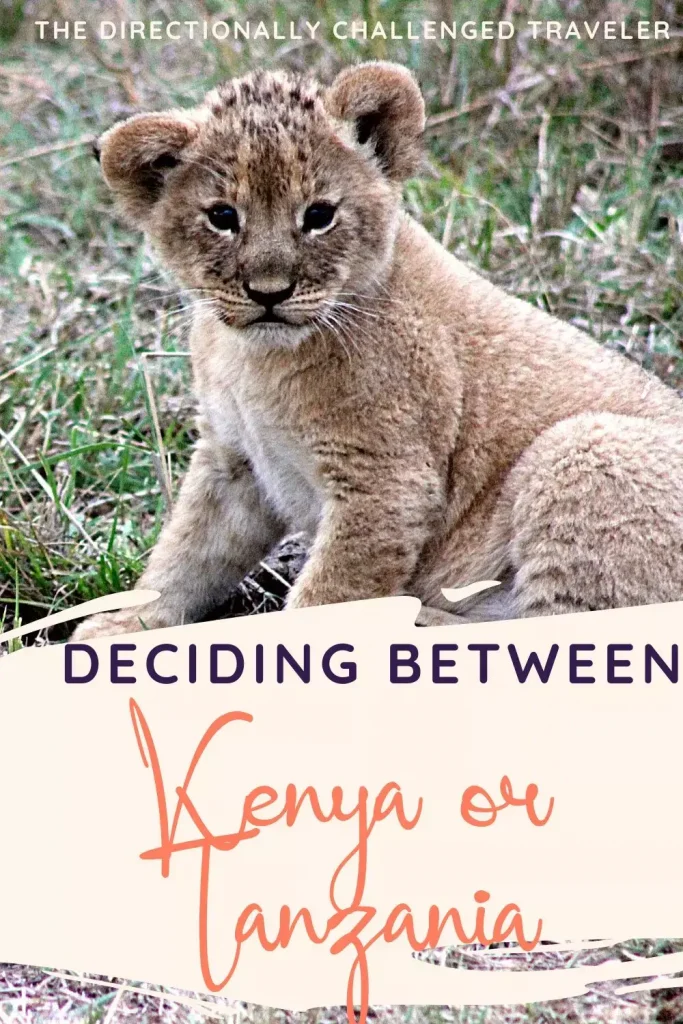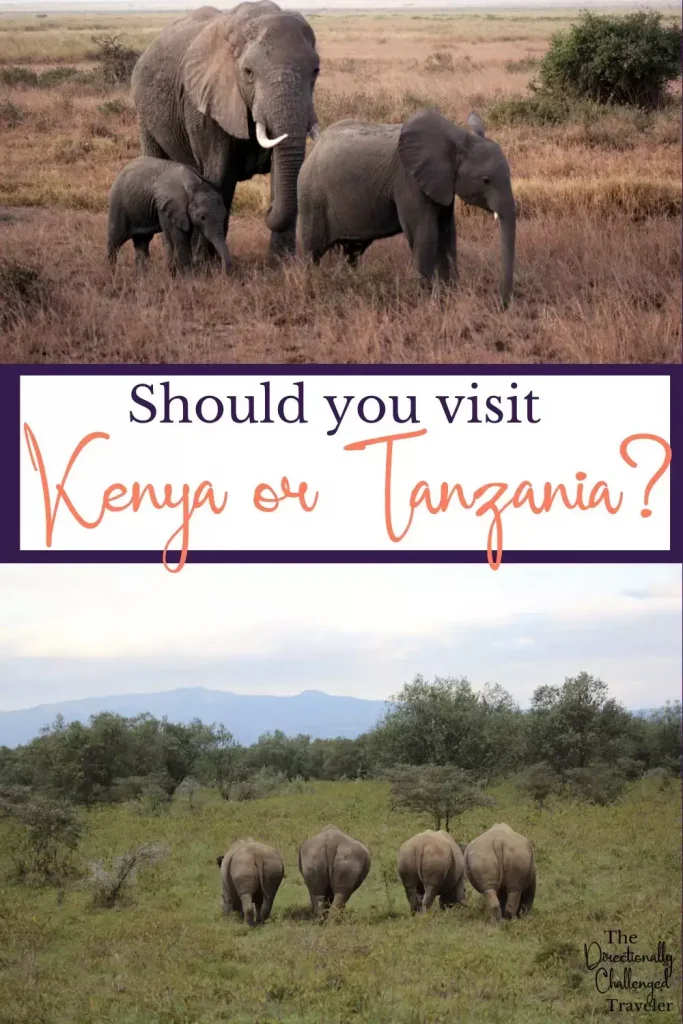When it comes to going on a trip to Africa, deciding between Kenya or Tanzania is the question most safari goers ask. While both destinations are worth a visit, the same may not be possible because of the limited time and budget needed to explore the two countries. Kenya and Tanzania are the most commonly visited countries in Africa for a safari.
Both countries have spectacular game viewing opportunities, cover different parts of the Great Wildebeest Migration, as well as the big 5 safari animals, and a plethora of other safari-related activities that defy comparison.
If you like this post, be sure to sign up for my e-mail list for travel inspiration (and get your FREE budget printable), or connect with me on Facebook, Instagram, Twitter, or Pinterest.
This post contains affiliate links. This means if you purchase something from a link, I may make a small commission, at no cost to you. This helps me keep the site running and free.

Wildlife
The northern part of Kenya is higher and drier, which means unusual species like the Samburu Special 5 are found here. These endemics include the Reticulated giraffe, Beisa oryx, Gerenuk, Somali ostrich, and Grevy’s zebra.
In comparison, the west of Tanzania is still an indigenous forest where one can go chimp trekking in the Mahale Mountains. The Ruaha National Park, down south, is the biggest terrestrial conservation area in the world. Bird watching is incredible – both countries boast over 1,000 bird species recorded in both countries.
Both countries feature the big 5 safari animals – elephants, water buffalo, lions, rhinoceros, and the elusive leopard.

Scenery
When it comes to their terrain and general vibe, Kenya and Tanzania are notably alike (probably why this decision is so difficult). This is mainly owing to the fact that they border one another, hug the Indian Ocean coast and both have a two-season climate which is wet and dry.
Kenya has mountains on the inside, beautiful beaches on the outside, and fertile valleys in the middle. The Masai Mara stretched from Kenya into Tanzania. On the other hand, Tanzania is much larger with plains and plateaus running across the country. Mt. Kilimanjaro is officially in Tanzania but you can see it from Kenya!
Accommodation
Your preferred type of accommodation is highly personal, like your budget. Staying options in both Kenya and Tanzania can vary from Meru tents to high-tech space bubbles to extravagant suites built on rock faces in Samburu.
Resorts in either country fill up fast, so if you want to travel during the peak season, be sure to book at least a year in advance.
The Giraffe Manor in Nairobi is very popular and has a long waiting list. Be sure to enquire a year or more in advance. There’s a wide variety of types of accommodation on safari. Glamping in the Masai Mara with Mara Bush Camp was an incredible experience.

Safari activities in Kenya & Tanzania
The twice-daily game drives are the main activities in the parks of both countries. This is the classic way of game viewing and passing the day. There are other extras, depending on where you are staying like, hot air balloon rides, guided nature walks, off-road game drives, night driving etc, which are mostly available in private conservancies, in which case Kenya is far better equipped than Tanzania.


Kenya vs. Tanzania: Traveler types
In general, Kenya is more suitable for families with young children as most of the lodges are catered to family-friendly elements. While Tanzania is on the up, Kenya still holds the edge by far.
Couples and adventure seekers can be in a dilemma as both Kenya and Tanzania offer sensational honeymoon infrastructure and exciting activities like camel and chimp tracking. For migration viewing, Kenya holds the edge due to the number of private conservancies, but if you have money to splurge, the viewings in Tanzania are superb.

Budget
Both Kenya and Tanzania are iconic wildlife destinations, conveniently close to each other, so it would be a shame to visit one and not hop across the border to see the other.
Most budget safaris to the two countries last between ten to fifteen days, giving you enough time to soak in the real flavor of the area’s wildlife and landscape.
A budget trip to Masai Mara for a three-day safari in a tented camp will always be cheaper than a three-day camping safari in Ngorongoro Crater and Serengeti due to the location and higher park fees.
You can get to Masai Mara by public transport and then do the game drives from your lodge, which is not possible in Serengeti as there is no such transport facility available.
Crowds in Tanzania & Kenya safaris
This is related to budgeting, I promise. Both countries are world-renowned safari destinations, meaning during the peak season, there will be an influx of tourists (especially true for the Great Migration). Kenya has more camps, lodges, and hotels meaning you’ll find cheaper prices – and thus more crowds. Tanzania is more expensive and exclusive because of the limited number of accommodations.
Payment options for Kenya
When booking a Kenyan safari, the first thing to keep in mind is to keep cash in Kenyan shillings for shopping and tipping. A couple of thousand Kenyan shillings ($20) per day should be sufficient. Be sure to get smaller notes in advance as ATM machines are not found everywhere.
If you book from your home country, a three-day budget safari will start from $800, an amount not many can afford. If you book in Nairobi, you will probably end up paying half or $400 for a Madai Mara three-day trip in basic accommodation.
Typical modes of payment for safari operators in Kenya include credit card (Visa or MasterCard) through a secure online payment mode or through PayPal. However, PayPal charges hefty fees in some countries as much as 8% per transfer.
Once your booking is confirmed, your operator will send you an invoice with a link that directs you to a secure online payment platform. All credit card payments attract a surcharge of between 3% to 7% depending on your credit card company.
Payment can also be made by debit card in a similar manner, but bank transfer fees of 3% to 5% will still apply. Therefore, if you wish to use plastic, ask beforehand.
Bank transfers are also accepted by safari companies, however, you need not use the bank but instead a specialist money transfer company (like Wise) to pay much smaller transfer charges.
Payment options for Tanzania
There are many options to pay for your Tanzanian safari like paying an initial deposit and balance at a later point in time.
While the best payment option is to pay the balance amount in cash on arrival in Tanzania, many people are not comfortable with carrying large amounts of money. An easy and convenient solution to this problem is local bank transfer.
You can make the full payment from your home country through a local bank transfer in USD, UK Pounds, AUD or German Euros. Banks in Tanzania process payments very slowly and it takes a minimum of three days for the money to get credited in the account. International bank transfer can be done for other currencies.
Again there are overhead charges you will have to pay such as, your bank’s charges, the intermediary bank charges and charges by the end use bank, which can really play havoc with the budget.
You can also use a credit or debit card to make the payment by paying a card processing fee of between 5% to 10% and it takes two weeks for the transaction to complete. Again, using a reliable money transfer company is the best option.

Concluding thoughts on Kenya vs. Tanzania?
In a world of tough choices, Tanzania is more expensive as the national parks are larger and spread out. If you have a big budget and lots of time, then we recommend Tanzania. Short on cash and only a few days in hand, head to Kenya.
Read More about Kenya
Visit the Sheldrick Wildlife Trust in Kenya
FAQ for Visiting Amboseli National Park in Kenya
Save “Kenya or Tanzania for Safari?” for Later
Author Bio

This post is a guest post by fellow travel blogger, Jyotsna. Check out her bio and website below!
Jyotsna Ramani is a passionate writer and an avid globetrotter. She loves putting pen to paper and sharing her worldly adventures on her travel blog – https://wanderwithjo.com/




Amazing and Informative post
Thanks for sharing this great post
Informative post
Amazing Post